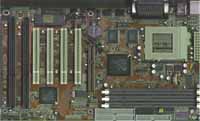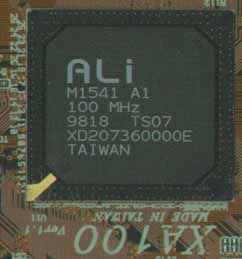Iwill XA100 Aladdin V Super7 Board
by Anand Lal Shimpi on May 25, 1998 1:58 PM EST- Posted in
- Motherboards
As Intel demolishes the Socket-7 environment with their Celeron/EX on the low end and their Deschutes/BX combos on the high end, a manufacturer needs to stay swift in order to outrun the competition in this industry. Simply cranking out TX motherboards or even Socket-7 AGP boards doesn't cut it anymore, users demand more and they are not willing to pay the outrageous prices for a Slot-1 motherboard, what else is a manufacturer to do but meet these demands on the low end with a high end Socket-7 motherboard.
The above factoid can be found on the box and User's Manual of Iwill's newest AGP Socket-7 motherboard, the XA100. What sets the XA100 apart from the competition is the chipset the board was built around, Acer Lab's (ALi) Aladdin V, a Super7 (Socket-7 + AGP + 100MHz Front Side Bus) chipset.
Anand Tech Report Card Rating
96/A
| CPU Interface | Socket-7 |
| Chipset | ALi Aladdin V |
| L2 Cache | 512KB |
| Form Factor | ATX |
| Bus Speeds | 60 / 66 / 75 / 83 / 100 MHz |
| Clock Multipliers | 2.0x - 5.5x |
| Voltages Supported | 1.8v / 2.1v / 2.2v / 2.7v / 2.8v / 2.9v / 3.2v / 3.5v |
| Memory Slots | 3 168pin DIMM Slots (EDO/SDRAM) |
| Expansion Slots | 1 AGP Slot 4 PCI Slots 3 ISA Slots (1 Shared / 3 Full Length) |
| BIOS | AMI BIOS |
| Why follow the rest of the pack when you can set your own trends? This seemed to be Iwill's intention with the XA100, at a first glance the eye catching box the board arrived in depicted a pack of 3 Cheetahs (the animals, not the hard drives ;)...) against an African sunset backdrop, a highly unusual image for a motherboard, however if Iwill's intention was to be different they definitely accomplished it. Lifting up the top of the motherboard box doesn't reveal a cluttered assortment of cables and documentation, instead you see a cardboard pop-up bearing the logo: "Iwill -- Make Things Happen." |  |
This cover contains information on how to obtain technical support, the Iwill homepage address (listed about 4 times total), as well as some other interesting information about the company itself. Removing this cover thankfully doesn't reveal another one, instead you find the manual on top of the XA100, underneath which lies a box containing the proper HDD/FDD cables necessary to get your system up and running. Looking at the board itself produces a unique sight, the arctic gray color that is found on the PCI slots, IDE/FDC connectors, and the CPU socket is a very rare occurrence, although it does add a pleasing appearance to the motherboard. The ATX form factor Super7 board features a healthy 4 PCI, 3 ISA, and 1 AGP expansion slot layout complimenting the 3 DIMM slots for memory expansion. Courtesy of the Aladdin V chipset the XA100 can cache above 64MB of RAM, more specifically, a full 128MB cacheable memory area is possible with only 512KB of L2 cache. One of the unique qualities the Aladdin V chipset boasts is the internal L2 cache the chipset features, more specifically the M1541 chip has an integrated 16K x 10-bit Tag RAM as well as 16K x 2 L2 cache SRAM, both of which decrease cost and increase performance at the same time. For this reason you can expect an Aladdin V board to be cheaper than an equivalently equipped VIA MVP3 Super7 board. |
|
 |
The board itself looks like some of the newer BX motherboards in terms of size and layout, the XA100 closely resembles the ASUS P2B with the exception of the presence of a Socket-7 CPU interface. The upper left hand corner of the motherboard is home to an extremely tiny and out of the way green power LED indicator, a feature that can be found on most Tyan motherboards. Closer to the Socket-7 IC (Integrated Circuit) you'll find a sparse population of small to mid-sized Vendell capacitors, including some between the ATX Power Supply Connector and the CPU Socket in order to decrease fluctuations in the voltage supplied to your CPU and therefore increase stability. The voltage regulators on the XA100 don't feature heatsinks on them, however this failed to pose a problem during the reliability tests AnandTech conducted. Closer to the AGP slot you'll find the 456-pin M1541 Aladdin V chipset which makes the 100MHz Front Side Bus possible on the XA100. |
Tapping the power of the Aladdin V chipset is done through the use of an Epox-like single jumper configuration setup. A single jumper controls the clock multiplier settings while another controls the Front Side Bus speed selection, allowing you to choose from a list ranging from 60 - 100MHz, all of which operated in an extremely stable manner. Whatever problems plagued the Aladdin V chipset previously seemed to have been solved as Iwill proved to the world that they can construct a Super7 board built around this elusive chipset. The Aladdin V allows for Pseudo-Synchronous operation of the PCI/AGP Buses keeping them at around 33 and 66MHz respectively, removing the possibility of running into problems with your PCI/AGP peripherals. On the ISA end, the AMI BIOS allows you to manually set the AT Clock Frequency in order to prevent any problems your ISA peripherals may have.
The User's Manual provided by Iwill is a step away from the 'el-cheapo' User's Manual you're probably used to seeing packaged with ALi based motherboards, Iwill paid great attention to detail in the manual and although there is some room for improvement it is definitely a well made document. Also packaged with the motherboard are the ALi AGP GART VxD Drivers and the ALi Bus Master IDE drivers as well, both were installed for the AnandTech tests and each installation went without any problems at all.
Performance-wise, the XA100 blows away all standard Socket-7 motherboards as it allows for Pentium MMX and AMD K6 owners to take advantage of the 100MHz Front Side Bus Frequency, unfortunately the Cyrix 6x86MX tested didn't seem to want to work at the 100MHz FSB speed. Simply switching to the 100MHz FSB speed provides an average of a 10% increase in performance over its 66MHz counterpart, this is definitely a feature you'll need in order to get the full performance out of AMD's new K6-2 processor.
A 112MHz bus speed would have been nice, apparently FIC's VA-503+ (MVP3) does feature this setting and initial reports state that it is quite stable, however the 100MHz bus speed will have to do for now. Like the Epox Super7 Motherboard, the XA100 doesn't feature any CPU core voltage settings between 2.2v and 2.7v, making overclocking the K6-300 to 350 (100 x 3.5) virtually impossible. Other than those two oversights the XA100 is a job well done by Iwill.










0 Comments
View All Comments